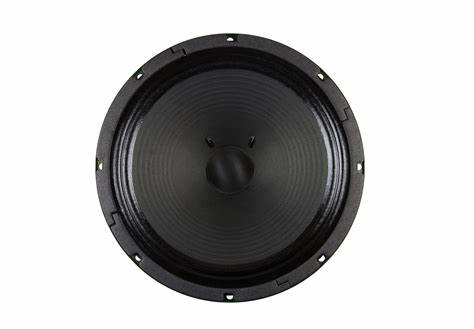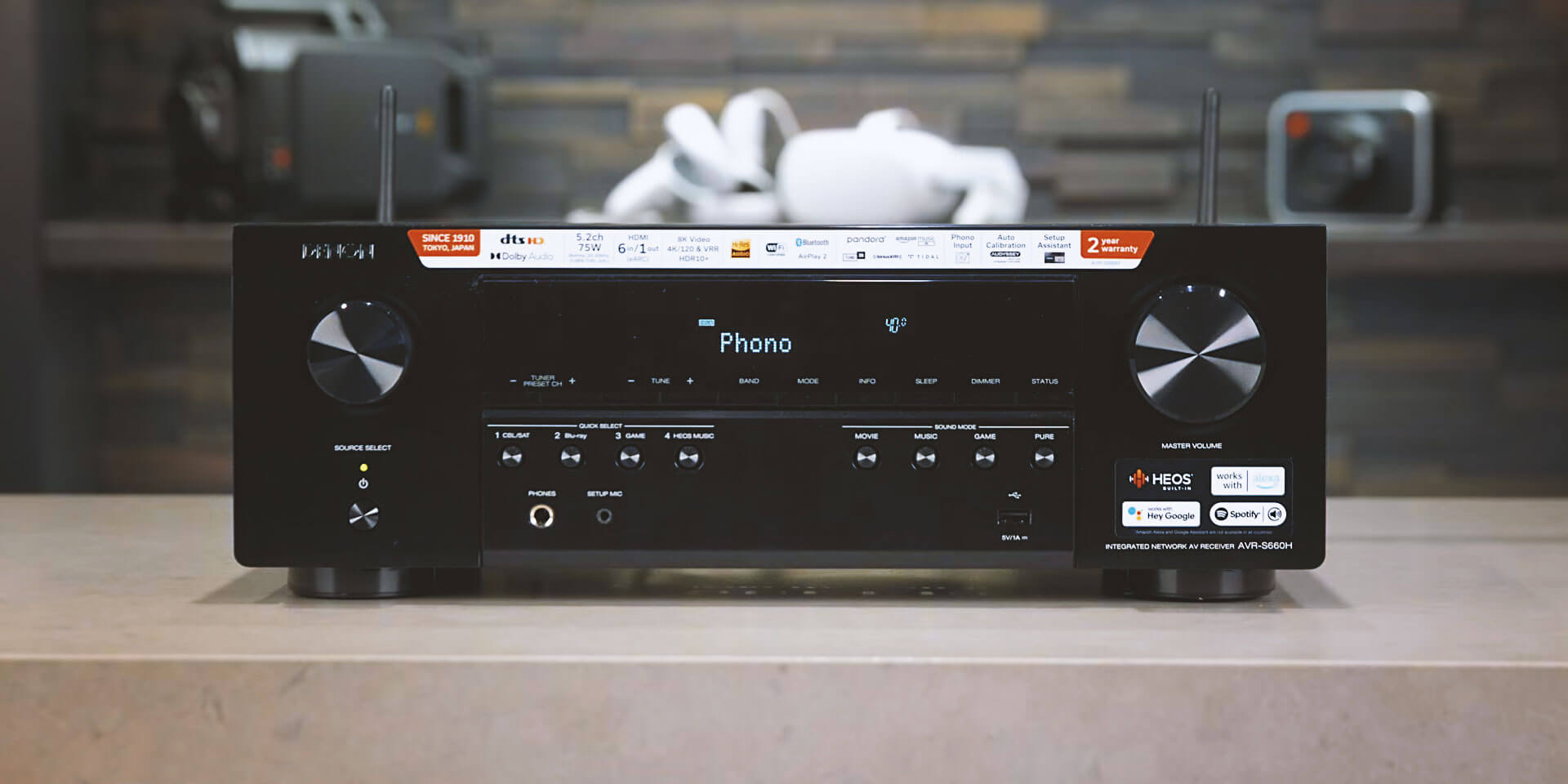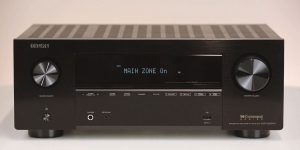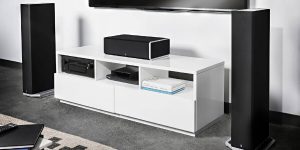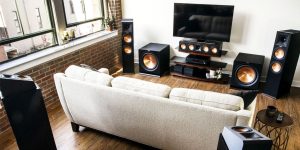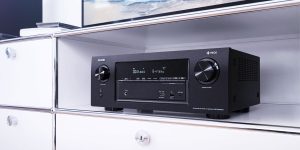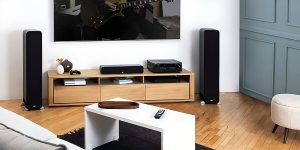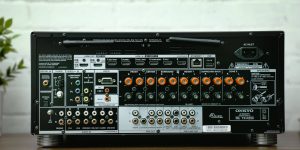The expensive multi-channel home theater receiver will not always be an optimal choice. For example, in a small room, you probably won’t need most of its features, or you won’t use the full power of this device. That’s why, based on my personal experience, I have selected the best 5.1 receivers available on the market for you.
I must say right away that in this review, I will also talk about 5.2 channel AVRs. The difference between them is that you can connect two subwoofers to the 5.2 amplifier, not just one, as in the 5.1 configuration.
5 channel surround systems: pros and cons
For the most part, the 5.1 AVR will be sufficient for standard tasks. Such receivers have an uncomplicated system speaker configuration. Let’s look at such a configuration in the example of the movie sound. First, the central channel provides the main stage for dialogues. Second, the left and right channels reproduce the soundtrack information. Next, the side channels allow us to get surround sound of different effects from music recordings. And finally, the subwoofer channel is responsible for low frequencies such as blasts.
In order to understand if this configuration is suitable for you, I will consider its advantages and disadvantages. I’ll start with the good stuff, namely the benefits:
- Very easy to set up;
- Great for uncomplicated and basic tasks;
- You can get enough sound quality in small rooms;
As for the cons, I can list the following points:
- Less quality surround sound;
- Not really suitable for large rooms (more than 40 square meters);
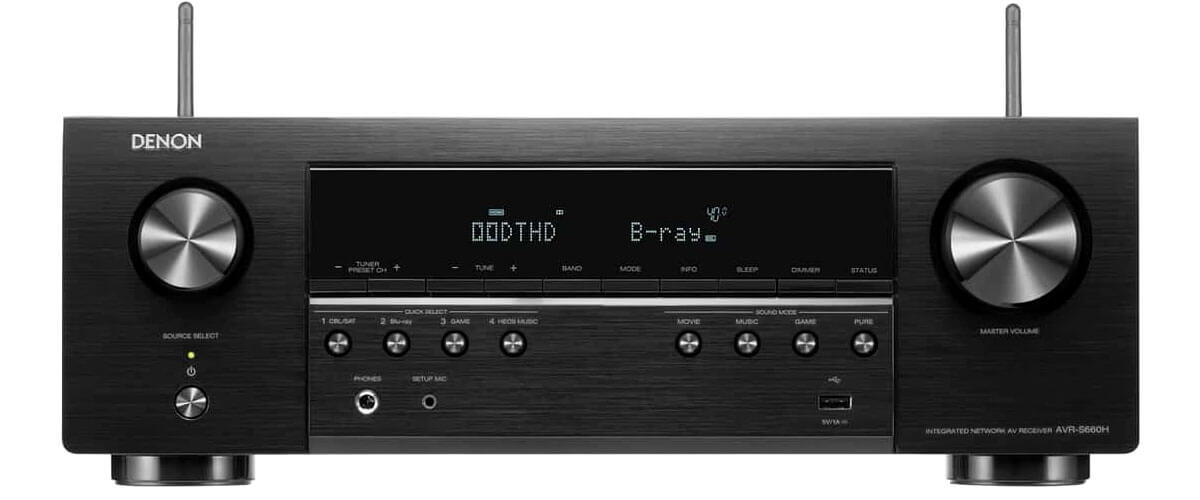
Read the full review.
5 Channel AV Receivers Comparison Table
| Name | Channels | Power output | HDMI in/out | Bluetooth/Wi-Fi | Review |
|---|---|---|---|---|---|
| Denon AVR-S660H best overall | 5.2 | 75W/8 Ohm, 100W/6 Ohm | 6/1 | yes/yes | Review |
| Yamaha RX-V385 budget pick | 5.1 | 70W/8 Ohm | 4/1 | yes/no | Review |
| Marantz NR1510 slim AVR | 5.2 | 50W/8 Ohm, 60W/6 Ohm | 6/1 | yes/yes | Review |
Best 5 channel AV receiver reviews
Denon AVR-S660H – best overall

I’m going to start with my favorite, the Denon AVR-S660H. In 2021, this receiver replaced the S650H, and at the moment, it’s the most modern model among the others on my list.
The AVR has a 5.2 channel amplifier with 75W per channel (8 ohms, 20Hz – 20kHz, Total Harmonic Distortion: 0.08%). Unfortunately, there is no support for multi-room zones. Instead, you can use HEOS Multiroom or AirPlay 2.
During the test, I was impressed with the excellent picture quality. This is possible thanks to supporting 8K resolution at 60Hz. With it, the image on the screen looks clear and detailed. It also supports 4K/120Hz and HDR10+, Dolby Vision, ALLM (Auto Low Latency Mode), VRR (Variable Refresh Rate), and QFT (Quick Frame Transport).
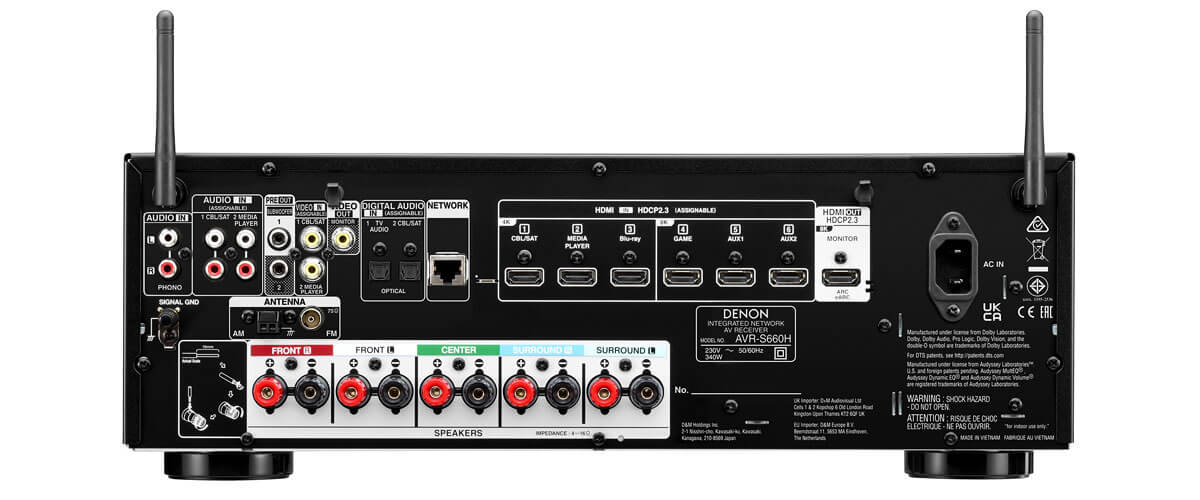
The Denon AVR-S660H supports Lossy (MP3, WMA, AAC) and Lossless (FLAC, ALAC, WAV) formats. It is also equipped with Audyssey MultEQ technology. Therefore, sound calibration is very fast and easy. A nice bonus is the presence of voice control through Alexa, Apple Siri, and Google Assist.
Now, let’s talk a little bit about connectors and connection methods. The AVR-S660H has six HDMI inputs (2.1), three of which support 8K pass-through, HDCP 2.3, and ARC/eARC technology. Three HDMI 2.1 ports with 40Gb/s support are the model’s most significant advantage over its competitors. There is only one HDMI output. Possible connection methods include two subwoofer outs, Wi-Fi, Bluetooth, and Ethernet Ports. By the way, there is a Phono (MM) input, which is another advantage of this model.
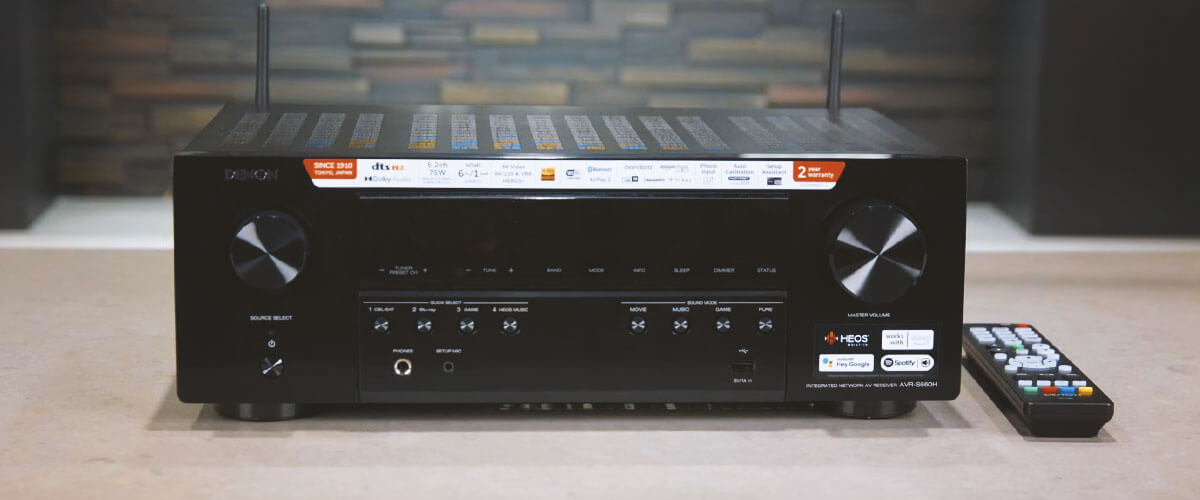
The receiver supports DTS Neo: 6, DTS HD Master, Dolby TrueHD, Dolby ProLogic II, Multichannel Stereo, and Dialog Enhancer. When I tested the sound, I didn’t think the S660H could surprise me. But it did. I chose “Dune” for the test and had a great experience. With the Dialog Enhancer technology, I experienced the characters’ communication differently. The emotions were more vividly conveyed, and the mesmerizing sounds of the mysterious planet filled my room. Of course, with only five available channels, the S660H may lose a little in overall accuracy, but the overall score is excellent. So if you like watching movies at home and popcorn + dynamic action combos, this model is perfect for you.
To summarize, I can confidently say that the AVR-S660H is the best 5.2 receiver overall on my list. This product from Denon is clearly ahead of its competitors in sound quality, has a few rare features in this price range, and is easy to set up and use. A true leader of the top!
Key specs
- Channels: 5.2.
- Power output: 75W/8 Ohm, 100W/6 Ohm.
- HDMI inputs/outputs: 6/1.
- Video functions: 4K/60Hz, 4K/120Hz, 8K/60Hz pass-through, upscales HD video signals to 8K Ultra HD.
- Bluetooth/Wi-Fi: yes/yes.
- Streaming services: AirPlay 2, Pandora, Spotify, Napster, SiriusXM, TIDAL, Deezer, Qobuz, Amazon Music.
- Suppots: HDMI ARC, HDMI eARC, HDMI CEC, HDCP2.3, HDR10+, Dolby Vision.
- Surround sound: DTS HD Master, Dolby TrueHD, Dolby ProLogic II.
Pros
- Advanced 8K pass-through.
- Voice control.
- ALLM, VRR, and QFT support.
- Sound is easy to calibrate thanks to Audyssey MultEQ.
- Two subwoofers out.
- Phono (MM) input is present.
Cons
- Limited capabilities of surround sound.
- No multi-room zones.
- Only one HDMI output.
Yamaha RX-V385 – budget pick

Yamaha RX-V385 is the second on my list. It is an inexpensive but sufficiently productive receiver of the economy class.
This 5.1 AV receiver has about 70 watts per channel (8 ohms, 0.09% THD). You will not find multi-room zones and similar functions here, as this device belongs to the budget models.
With the RX-V385, you can watch a movie in 4K Ultra HD resolution (60Hz). The AVR includes standard technologies such as HDR10, Dolby Vision, HLG, and BT.2020. The picture quality is good enough but still far from perfect. I can’t say anything special about the quality, but for family viewing, it is suitable.
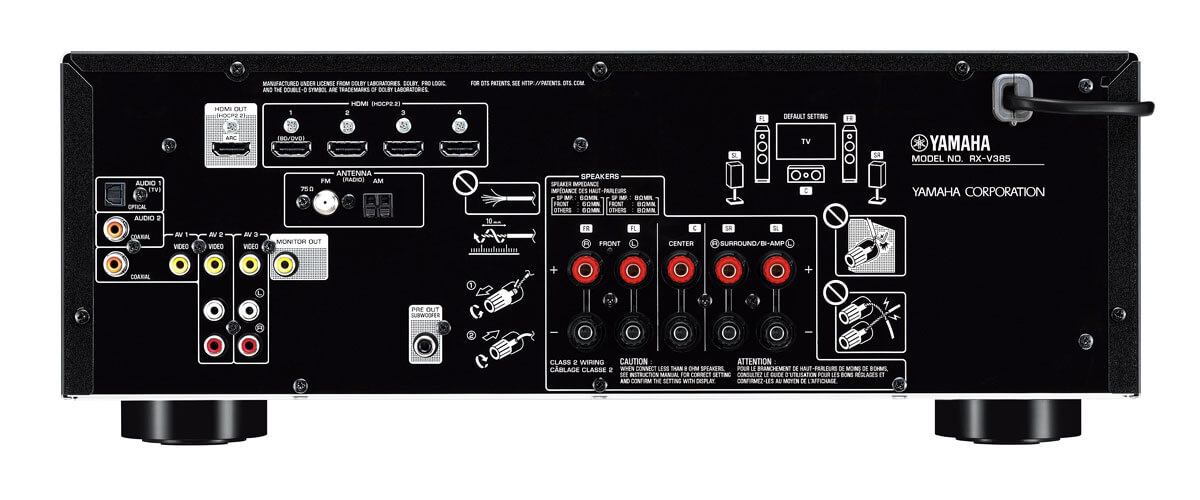
The model supports Lossy and Lossless formats. If you want to calibrate sound, then YPAO can help you. This unique development from Yamaha will analyze your room and automatically adjust the sound without any problems.
Considering the number of available connectors, there are 4 HDMI inputs (2.1) and 1 HDMI output (2.1) with HDCP 2.3 / eARC support. In this case, the receiver with one subwoofer output and Bluetooth connectivity.
Now a little more about the sound. The receiver is equipped with Yamaha’s exclusive Cinema DSP technology. It supports HD Audio playback, making the sound more natural and expansive. Also, with Virtual Cinema Front, you have the ability to get good virtual surround sound by placing the speakers only at the front of the room. During the test, I especially liked the sound of the bass, which was dynamic and rich.
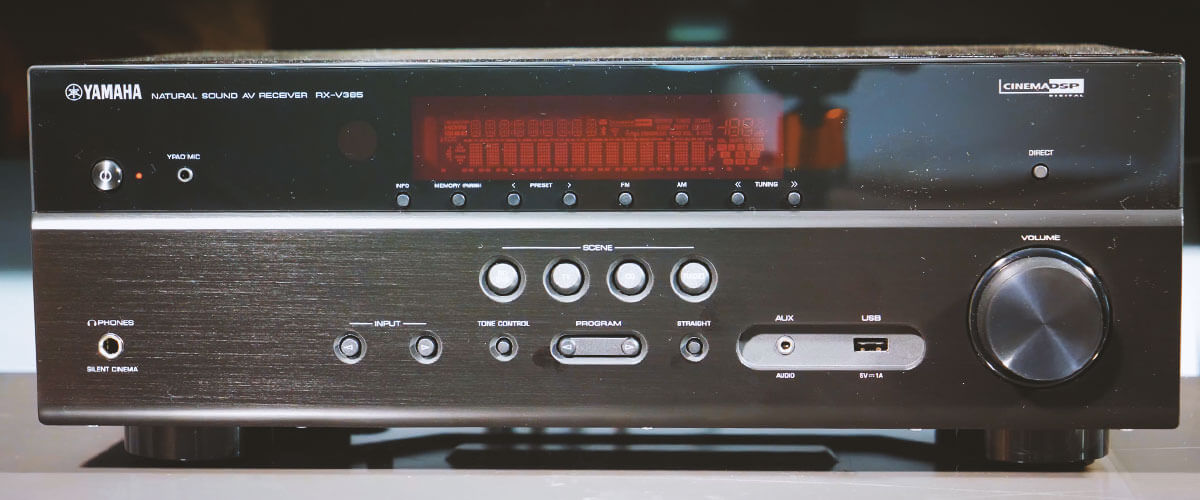
If you compare this model with the Sony STR-DH590, the RX-V385 is slightly better than the competitor. Both devices support basic functions. But Yamaha has 5 HDMI (2.1) ports with HDCP 2.3 and eARC support instead of HDMI version 2.0 ports with HDCP 2.2/ARC support.
In short, it is the best budget 5.1 receiver with typical Yamaha quality. It is easy to set up, equipped with all the necessary functions, and does its job very well. Great for undemanding home use.
Key specs
- Channels: 5.1.
- Power output: 70W/8 Ohm, 130W/6 Ohm.
- HDMI inputs/outputs: 4/1.
- Video functions: 4K/60Hz pass-through, upscales HD video signals to 4K Ultra HD.
- Bluetooth/Wi-Fi: yes/no.
- Streaming services: no.
- Suppots: HDMI ARC, HDMI eARC, HDMI CEC, HDMI Upscaling.
- Surround sound: DTS HD Master, Dolby TrueHD, Dolby Digital Plus, Cinema DSP.
Pros
- 4K Ultra HD pass-through.
- Cinema DSP and Virtual Cinema Front are present.
- Simple set up via YPAO.
- All HDMI ports version 2.1.
Cons
- Only 1 HDMI output.
Marantz NR1510 – slim AVR
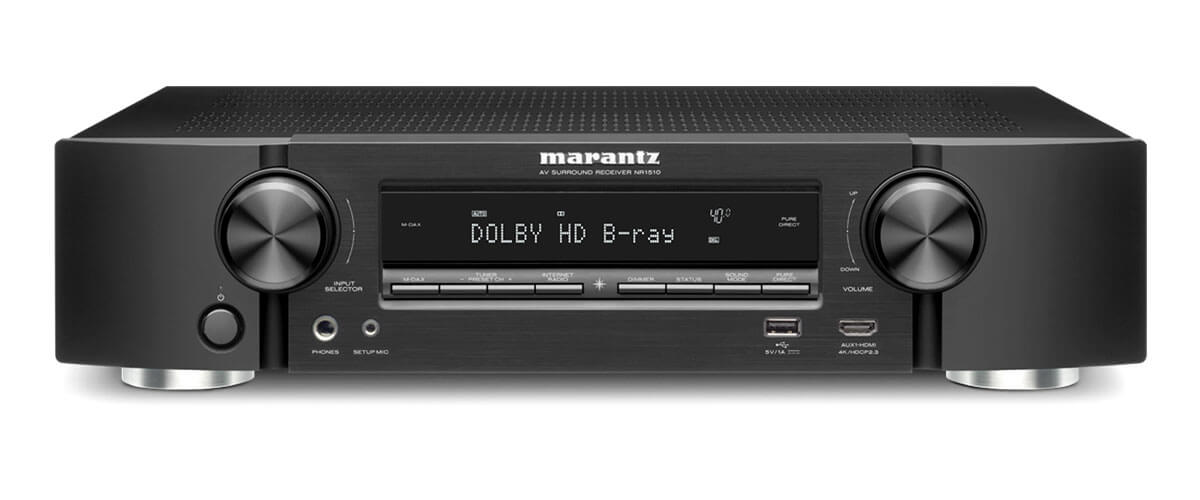
My next choice is the Marantz NR1510. I would have to say that this is the most expensive model of today’s top five. So, what can the receiver boast? Let’s figure it out together.
The AVR is equipped with a 5.2 channel amplifier with 50W per channel (8 ohms, 20Hz – 20kHz, THD: 0.08%). You should also note that the device does not support multi-room zones (like his cheaper analogs, collected in my list). But there is HEOS, which almost completely makes up for the lack of multi-room technology.
As for the quality of the transmitted picture, everything is good. The NR1510 supports 4K Ultra HD at 60Hz, allowing for great picture quality on large TVs like 65 inches or so. There are also technologies such as Dolby Vision, HDR10, and HLG.

The AVR quickly processes and decodes various formats, such as Lossy and Lossless. You can adjust the correct sound of the speakers using Audyssey MultEQ technology. A special microphone is also included with the receiver, which will help with sound calibration. It does not require any complicated actions. So, I’m sure you can handle everything on your own.
The device has 6 HDMI inputs (version 2.0 / ARC) and 1 HDMI output (2.0) with HDCP 2.3 support. Available connection methods include 2 subwoofer outs, Bluetooth, Ethernet Ports, and WiFi. This model also features a Phono (MM) In.
The receiver is equipped with such technologies as Dolby TrueHD and DTS-HD Master Audio, which provide accurate and sufficiently detailed surround sound. In my opinion, the sound quality is quite in line with the price of the device. Moreover, I did not find any unpleasant surprises or defects.
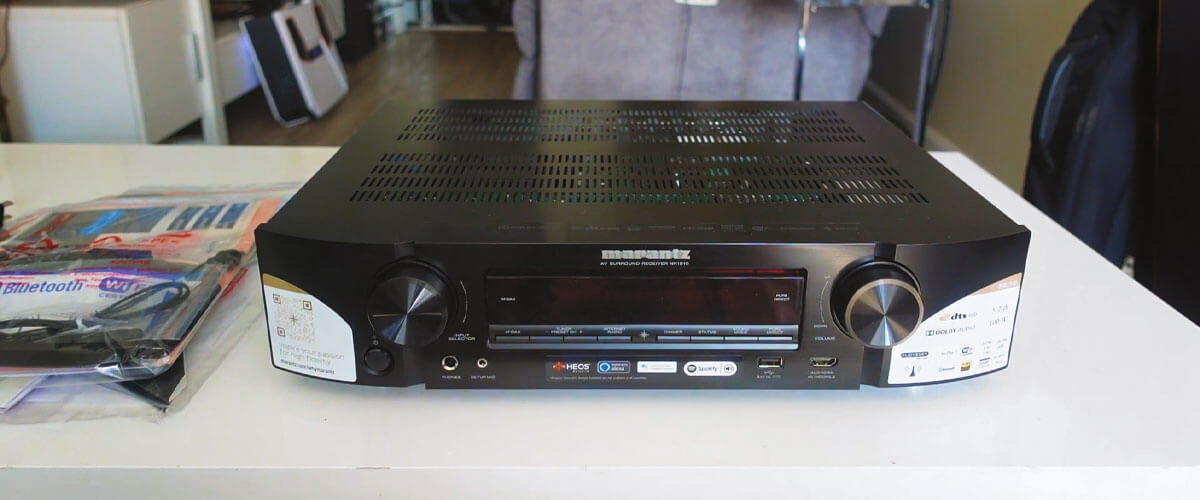
The main competitor of this model is the Denon AVR-S660H. I must say that Marantz NR1510 loses to it in many ways. The fact is that Denon, for a lower price, offers its users a more powerful amplifier, 8K resolution, version 2.1 ports, and eARC, which the NR1510 does not have. The only thing is that it is not as compact as the Marantz.
So, the 5.2 channel 4K receiver provides quite a good quality picture and sound in a slim body. The model is most suitable for small rooms. Overall, a decent device, but there are analogs on the market at a much more attractive price.
Key specs
- Channels: 5.2.
- Power output: 50W/8 Ohm, 60W/6 Ohm.
- HDMI inputs/outputs: 6/1.
- Video functions: 4K/60Hz pass-through.
- Bluetooth/Wi-Fi: yes/yes.
- Streaming services: AirPlay 2, Pandora, Spotify, Napster, SiriusXM, TIDAL, Deezer, Qobuz, Amazon Music.
- Suppots: HDMI ARC, HDMI eARC, HDMI CEC, HDCP2.3, HDR10, Dolby Vision.
- Surround sound: DTS HD Master, Multichannel Stereo, MDAX2.
Pros
- Compact profile.
- Supports 4K Ultra HD.
- Easy and fast set up thanks to Audyssey MultEQ.
- Phono (MM) input is present.
- It is possible to connect two subwoofers.
Cons
- Only 1 HDMI output.
- All HDMI ports version 2.0.
- No multi-room zones.
Sony STR-DH590
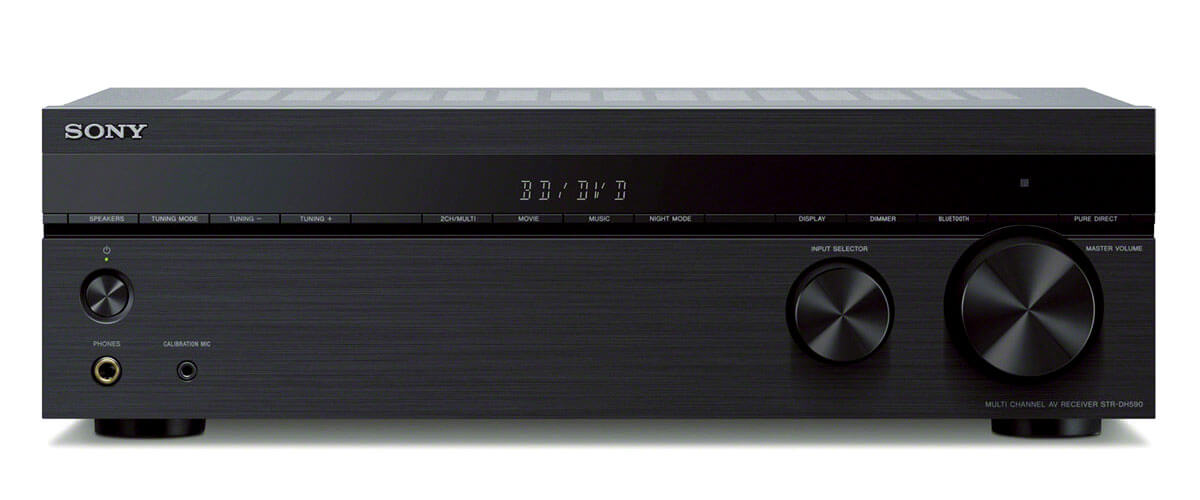
Next on my list is the Sony STR-DH590. The model was released in 2018. It belongs to the budget segment of receivers. The option is quite good and inexpensive, so let’s look at it in detail.
The manufacturer states that the receiver’s power is about 145 W, but this is only possible at a load resistance of 6 ohms per channel, 1kHz, and 0.9% THD. The real power of the device is 90 W (6 Ohms, 20Hz to 20kHz, 0.09% THD).
The AVR features Dolby Vision and the latest HDR standards. The picture quality is decent thanks to the support of 4K HDR pass-through at 60Hz. I especially want to mention the ability to playback 3D content.
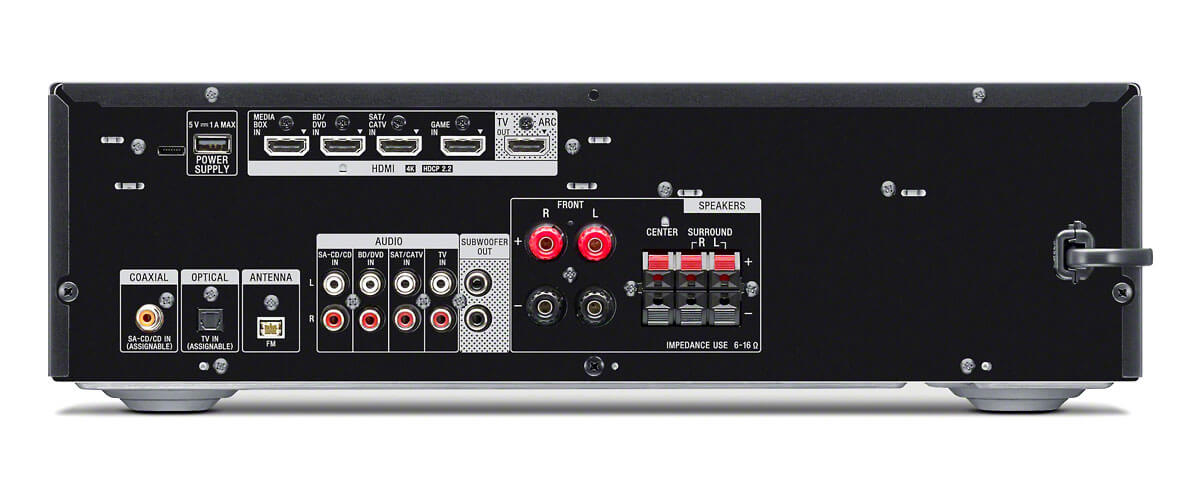
The STR-DH590 perfectly understands many audio formats. You can adjust the sound using the Digital Theater Auto Calibration (DCAC). I have nothing to add here, as the technology works like many other analogs of automatic sound calibration.
As for connections and ways to connect, the model has 4 HDMI inputs (2.0/ARC) and 1 HDMI output (2.0) with HDCP2.2 support. Although the Sony has 2 subwoofer outputs, they are treated as one in our case. You can also connect to the receiver via Bluetooth.
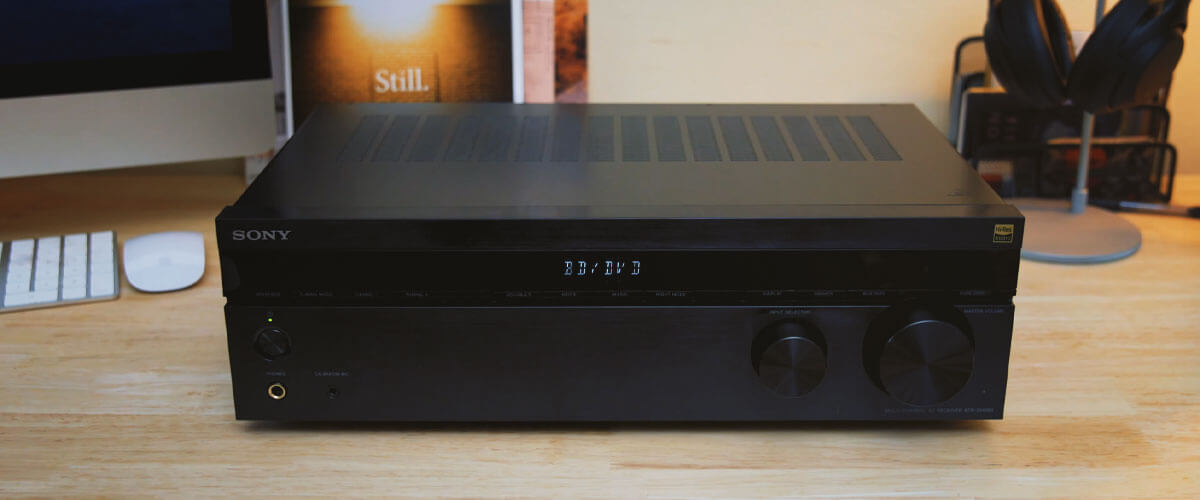
Now a little bit about the sound. It lives up to its price. The music sounds quite clear and dynamic with a flexible surround sound, but I didn’t find anything supernatural in the sound. By the way, I did not notice any strong distortions at high volume. The receiver supports basic technologies like DTS, DSD, Dolby Digital, Dolby Dual Mono, DTS-HD Master Audio, and DTS-HD High-Resolution Audio.
Finally, the Sony STR-DH590 will be a good choice for everyday home use. It offers decent picture quality with 4K UHD and a pretty dynamic surround sound in this price range.
Key specs
- Channels: 5.2.
- Power output: 145W/6 Ohm.
- HDMI inputs/outputs: 4/1.
- Video functions: 4K/60Hz pass-through.
- Bluetooth/Wi-Fi: yes/no.
- Streaming services: no.
- Suppots: HDCP2.2, HDR10, Dolby Vision.
- Surround sound: DTS HD Master, Dolby Digital.
Pros
- 4K UHD resolution.
- There is support for 3D content.
- Good enough sound for its price.
- Supports the latest HDR formats.
Cons
- One HDMI output.
- HDMI ports version 2.0.
- No Wi-Fi support.
Yamaha RX-V4A
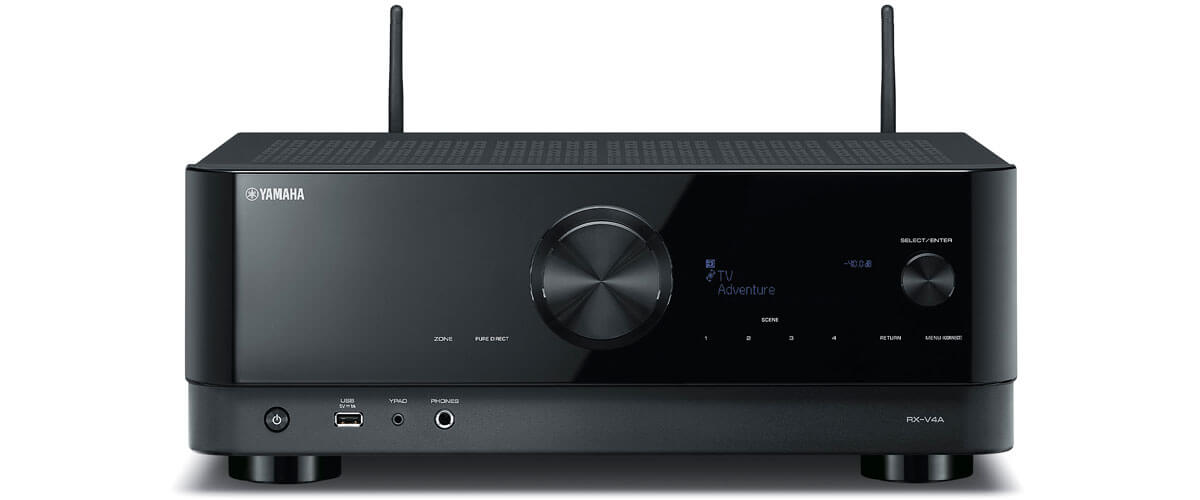
Well, we came to my last choice, the Yamaha RX-V4A. The model was released in 2020 and still remains a relevant option. And now, I’ll tell you why.
I’ll start with the power of the device. The receiver has a 5.2-channel amplifier with 80W per channel (6 ohms, 0.06% THD). So, it’s great for small and medium-sized rooms. In addition, you can control multi-room audio through the MusicCast app.
I was happy to see 8K pass-through (60Hz) support in this model. Not every receiver in this price range can offer similar picture quality. While watching the movie, all the details look very clear with good color reproduction. So, if you have a big TV at home, there will be no problem with the resolution. Supported technologies include Dolby Vision, HDR10+, and Hybrid Log-Gamma. The support for VRR, ALLM, QMS, and QFT will become a bonus for gamers.
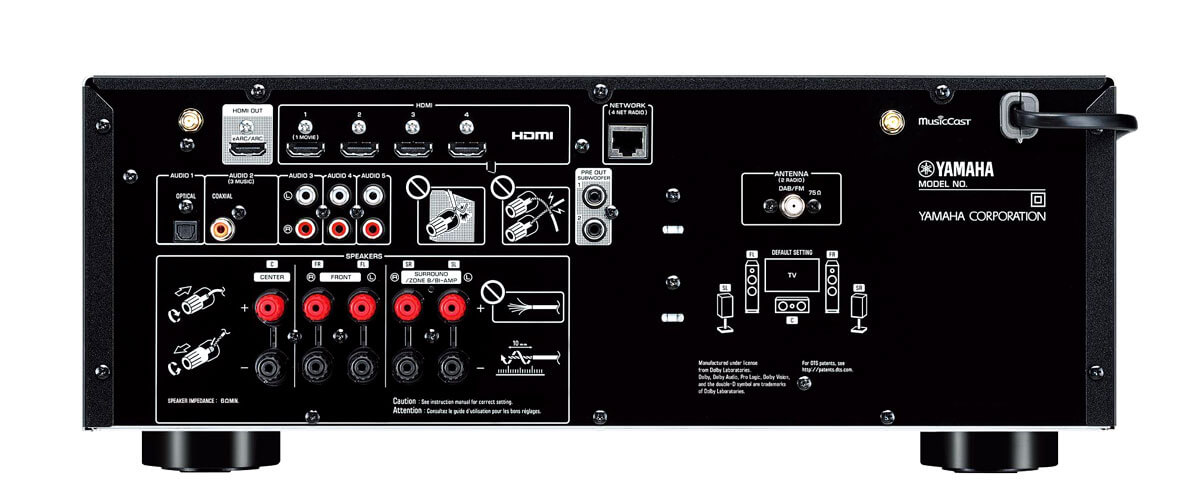
Yamaha RX-V4A has 4 HDMI (2.1) inputs and 1 HDMI (2.1) output with HDCP 2.3 and eARC support. The device also has 2 subwoofer outs, Wi-Fi (2.4/5GHz), AirPlay 2, and Bluetooth.
After automatically adjusting the sound with Yamaha’s YPAO technology, you’ll get pretty good results. The music will be played clearly, atmospherically, and dynamically. This is also partly due to Dolby TrueHD, Dolby Digital Plus, and DTS-HD Master Audio. Unfortunately, there are no modern formats like Dolby Atmos or Dolby Surround.
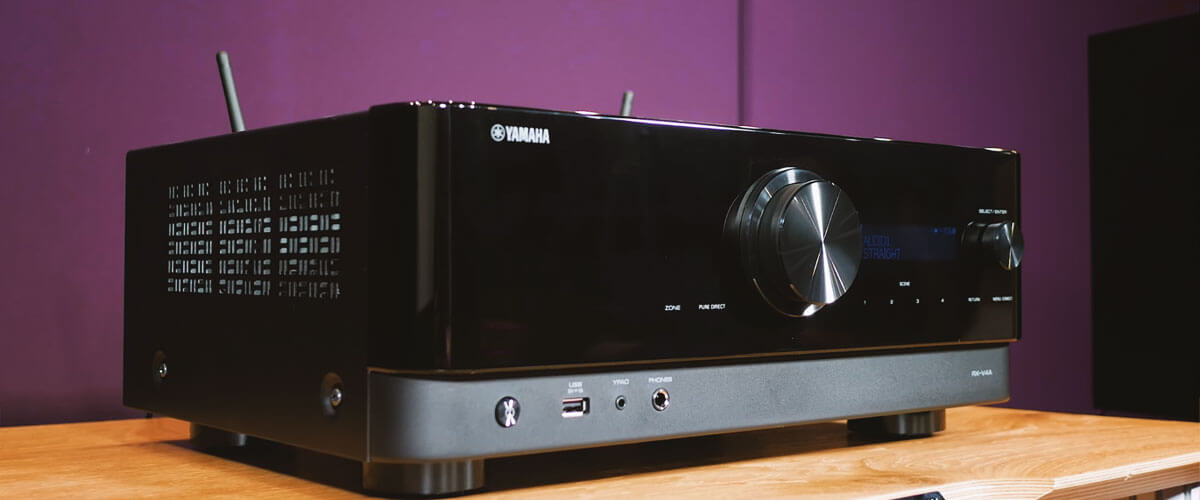
Yamaha RX-V4A and Denon AVR-S660H cost about the same. In addition, it is difficult to single out any noticeable advantage. But I still give preference to the second device. Aside from its performance and high-resolution video content, the AVR also offers Phono (MM) input and more ports, making it more universal for different user needs.
The main advantage of the RX-V4A is support for 8K resolution with technologies such as ALLM, VRR, QMS, and QFT. The receiver performance and a variety of connection methods make it a good solution for building a home theater. The only thing I don’t like is the low number of ports.
Key specs
- Channels: 5.2.
- Power output: 80W/6 Ohm.
- HDMI inputs/outputs: 4/1.
- Video functions: 4K/60Hz, 4K/120Hz, 8K/60Hz pass-through, upscales HD video signals to 4K Ultra HD.
- Bluetooth/Wi-Fi: yes/yes.
- Streaming services: AirPlay 2, Pandora, Spotify, Napster, SiriusXM, TIDAL, Deezer, Qobuz, Amazon Music, MusicCast.
- Suppots: HDMI ARC, HDMI eARC, HDMI CEC, HDCP2.3, HDR10, HDR10+, Dolby Vision.
- Surround sound: DTS HD Master, Dolby TrueHD, Dolby Digital Plus, Cinema DSP.
Pros
- There is an 8K resolution.
- Voice control.
- Game-oriented device.
- The latest HDR formats are present.
- Easy operation.
- It is possible to calibrate the sound with YPAO.
Cons
- A few HDMI ports.
- Phono (MM) input is not available.
- No Dolby Atmos technology.
5 channel AVR buying guide
Many new users often can’t decide about the AVR they need. This section is designed to help you do just that. So, how do you choose the best 5.1 receiver?
First of all, you need to pay attention to the following parameters of the device:
Depending on this indicator, the price of the model can vary significantly, up or down. An amplifier with about 70-100W per channel will be sufficient for small to medium-sized rooms. That’s why all the receivers in my review have approximately these parameters.
- The number of connectors
It is one of the essential aspects of choosing a suitable device for you. Firstly, you must clearly understand how many connectors you need. This way, you can determine for yourself the necessary amount of them. It is great if all HDMI ports are version 2.1 and also support eARC. As for Phono (MM) In or 2 subwoofer outs, not all AVRs have them. That’s why you have to check it yourself.
- The connection methods and supported music services
Different ways of connection make the receiver much easier to use. Nowadays, I don’t recommend considering the options which do not have the ability to connect via Wi-Fi and Bluetooth. In addition, it would be nice to see support for various music services, such as Spotify, Apple Music, Deezer, Tidal, and others.
- The desired video resolution
Which video resolution you should choose depends on the size of your TV. For example, a movie in Full HD resolution on a 65-inch screen will look terrible. I recommend you buy a receiver with 4K support because it will fit you in most cases. You’ll also find more video content in 4K than 8K resolution.
- The sound capabilities of the device
It’s cool if the 5.1 surround sound receiver supports such new formats as DTS:X and Dolby Atmos. But specifically, in this review, all models have earlier technologies like Dolby TrueHD, DTS-HD Master Audio, and others
